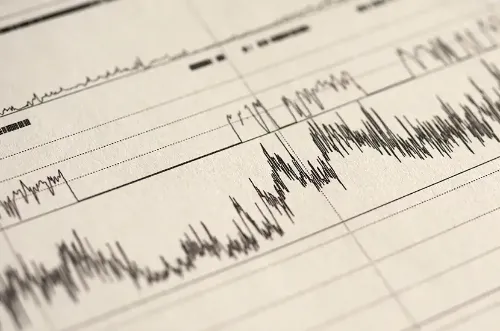Parasomnias
"They are chronic disorders, usually dragging on from early childhood. In a low percentage of patients they extend beyond adolescence".
DR. ELENA URRESTARAZU
PERSON IN CHARGE. SLEEP UNIT

Parasomnias are a group of very varied alterations, generally benign, more typical of childhood or adolescence, but which can sometimes last and persist into adulthood.
They are classified according to the phase of sleep in which they appear and their meaning. Some appear in the transition of the dream to the wakefulness (of the waking up) or of the wakefulness to the dream, others are typical of the slow dream, and others of the phase REM.
The most frequent are the speaking during the dream or the episodes of confusion when waking up.

What are the symptoms of parasomnias?
Most common symptoms:
- Sleepwalking.
- Night terrors.
- Nightmares.
- To wake up confused.

Learn about sleep disorders and how they are treated (only in spanish)
Do you have any of these symptoms?
You may have a parasomnia
Parasomnias of awakening
Sleepwalking
It is a common disorder in childhood and usually disappears with age. It consists of the development, during the phases of the deep dream, of behaviors that habitually include the walking.
Before beginning to walk, the patient sits on the bed and looks around in a confused manner. The eyes usually remain open and with a sense of wonder. Patients are deeply asleep and it is difficult to wake them from sleep. They do not remember what happened.
There is no treatment for this problem, and only incidental accidents should be avoided.
Night terrors
It is characterized by the sudden appearance and during the deep sleep phases of unexpected crying or screaming episodes, with a facial expression of intense fear or terror.
It is usually accompanied by increased heart rate, breathing and significant sweating.
It is normal for the patient to remain seated in bed, deeply asleep and difficult to wake.
Confusionary awakening
It is characterized by the appearance of a confusing picture when waking up from sleep. Patients wake up disoriented in time and space, with slowed brain response and decreased attention and response to stimuli.
It is more frequent in children and young adults and, habitually, they disappear with the age.
Parasomnias associated with REM sleep
REM sleep behavior disorder
These are abnormal behaviors that appear during REM sleep. Instead of presenting a total loss of muscle tone (as normally occurs in REM sleep), the patient presents violent movements such as punches or kicks that correspond to the motor activity of ongoing dreaming.
As a result, patients may self-injure or injure the bed partner.
Isolated sleep paralysis
Inability to speak and perform any voluntary movement with the head, trunk or limbs due to a complete loss of muscle tone.
It may last a few seconds or minutes and the patient experiences a lot of anxiety and may have hallucinations.
Nightmares
Very experienced dreams of unpleasant content and produce an important sensation of fear.
The patient usually remembers them and is aware of what happened when he or she wakes up.
How are parasomnias diagnosed?

The diagnosis of parasomnias is mainly made by the history told by the companions, and by what the patient himself can add.
The first thing is to diagnose the episodes exactly. To do this, it is necessary to observe them by performing a sleep study. If possible, the electroencephalogram and other variables are recorded during the night and the image is recorded on video.
There are recording systems with infrared lights that allow the patient to sleep in a practically normal situation.
The EEG and video study will serve to know in what phase of sleep the episodes occur, and how they are. It also serves to rule out other phenomena, such as epilepsy, which is the disease that must be excluded in these patients.
How are parasomnias treated?
The treatment of parasomnias will depend on the specific parasomnia. Some do not have and some do not need treatment; but others have and need treatment.
The REM sleep behavior disorder is one of the parasomnias that they have and need treatment; they are disorders that due to their violence are sometimes important, and respond very well to treatment with nocturnal benzodiazepines, specifically clonazepam.
In general, it is recommended to protect the environment where the person sleeps to avoid accidents. In case of witnessing an episode, it is usually tried to accompany him back to bed, and that he continues to sleep, since although he is not conscious, it is usually possible to establish a minimum of communication; waking him up abruptly is neither good nor bad, it can only produce an unpleasant situation with perplexity and fright.
Where do we treat it?
IN NAVARRA AND MADRID
The Sleep Unit
of the Clínica Universidad de Navarra
Accredited by the Spanish Sleep Society, the Clinic's Sleep Unit has the latest advances in diagnosis and treatment of sleep disorders.
The joint work of the different medical and surgical disciplines that integrate the Unit of the Sleep of the Clinica does that every patient can be attended approaching his problem of global form, collaborating, if it is necessary, for different specialists.
Diseases we treat

Why at the Clinica?
- We have the best facilities to perform sleep studies.
- Nursing specialized in these disorders for their care and follow up.
- State-of-the-art technology and a highly specialized team.

















